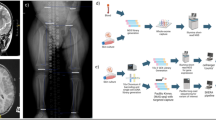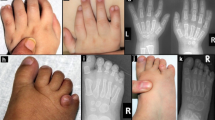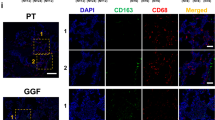Abstract
Megalencephaly-capillary malformation (MCAP) syndrome is an overgrowth syndrome that is diagnosed by clinical criteria. Recently, somatic and germline variants in genes that are involved in the PI3K-AKT pathway (AKT3, PIK3R2 and PIK3CA) have been described to be associated with MCAP and/or other related megalencephaly syndromes. We performed trio-exome sequencing in a 6-year-old boy and his healthy parents. Clinical features were macrocephaly, cutis marmorata, angiomata, asymmetric overgrowth, developmental delay, discrete midline facial nevus flammeus, toe syndactyly and postaxial polydactyly—thus, clearly an MCAP phenotype. Exome sequencing revealed a pathogenic de novo germline variant in the PTPN11 gene (c.1529A>G; p.(Gln510Arg)), which has so far been associated with Noonan, as well as LEOPARD syndrome. Whole-exome sequencing (>100 × coverage) did not reveal any alteration in the known megalencephaly genes. However, ultra-deep sequencing results from saliva (>1000 × coverage) revealed a 22% mosaic variant in PIK3CA (c.2740G>A; p.(Gly914Arg)). To our knowledge, this report is the first description of a PTPN11 germline variant in an MCAP patient. Data from experimental studies show a complex interaction of SHP2 (gene product of PTPN11) and the PI3K-AKT pathway. We hypothesize that certain PTPN11 germline variants might drive toward additional second-hit alterations.
Similar content being viewed by others
Log in or create a free account to read this content
Gain free access to this article, as well as selected content from this journal and more on nature.com
or
References
Moore CA, Toriello HV, Abuelo DN et al: Macrocephaly-cutis marmorata telangiectatica congenita: a distinct disorder with developmental delay and connective tissue abnormalities. Am J Med Genet 1997; 70: 67–73.
Clayton-Smith J, Kerr B, Brunner H et al: Macrocephaly with cutis marmorata, haemangioma and syndactyly—a distinctive overgrowth syndrome. Clin Dysmorphol 1997; 6: 291–302.
Toriello HV, Mulliken JB : Accurately renaming macrocephaly-cutis marmorata telangiectatica congenita (M-CMTC) as macrocephaly-capillary malformation (M-CM). Am J Med Genet A 2007; 143A: 3009.
Mirzaa GM, Conway RL, Gripp KW et al: Megalencephaly-capillary malformation (MCAP) and megalencephaly-polydactyly-polymicrogyria-hydrocephalus (MPPH) syndromes: two closely related disorders of brain overgrowth and abnormal brain and body morphogenesis. Am J Med Genet A 2012; 158A: 269–291.
Mirzaa G, Conway R, Graham JM, Dobyns WB : PIK3CA-related segmental overgrowth 1993 http://www.ncbi.nlm.nih.gov/books/NBK153722/ Last update 2013.
Mirzaa GM, Riviere JB, Dobyns WB : Megalencephaly syndromes and activating mutations in the PI3K-AKT pathway: MPPH and MCAP. Am J Med Genet C Semin Med Genet 2013; 163C: 122–130.
Riviere JB, Mirzaa GM, O'Roak BJ et al: De novo germline and postzygotic mutations in AKT3, PIK3R2 and PIK3CA cause a spectrum of related megalencephaly syndromes. Nat Genet 2012; 44: 934–940.
Döcker D, Schubach M, Menzel M et al: Further delineation of the SATB2 phenotype. Eur J Hum Genet 2013, e-pub ahead of print 4 December 2013; doi:10.1038/ejhg.2013.280.
Bertola DR, Pereira AC, Passetti F et al: Neurofibromatosis-Noonan syndrome: molecular evidence of the concurrence of both disorders in a patient. Am J Med Genet A 2005; 136: 242–245.
Carcavilla A, Santome JL, Pinto I et al: LEOPARD Syndrome: a variant of Noonan syndrome strongly associated with hypertrophic cardiomyopathy. Rev Esp Cardiol 2013; 66: 350–356.
Tartaglia M, Gelb BD, Zenker M : Noonan syndrome and clinically related disorders. Best Pract Res Clin Endocrinol Metab 2011; 25: 161–179.
Zenker M : Genetic and pathogenetic aspects of Noonan syndrome and related disorders. Horm Res 2009; 72 (Suppl 2): 57–63.
Kurek KC, Luks VL, Ayturk UM et al: Somatic mosaic activating mutations in PIK3CA cause CLOVES syndrome. Am J Hum Genet 2012; 90: 1108–1115.
Lindhurst MJ, Parker VE, Payne F et al: Mosaic overgrowth with fibroadipose hyperplasia is caused by somatic activating mutations in PIK3CA. Nat Genet 2012; 44: 928–933.
Lee JH, Huynh M, Silhavy JL et al: De novo somatic mutations in components of the PI3K-AKT3-mTOR pathway cause hemimegalencephaly. Nat Genet 2012; 44: 941–945.
Rios JJ, Paria N, Burns DK et al: Somatic gain-of-function mutations in PIK3CA in patients with macrodactyly. Hum Mol Genet 2013; 22: 444–451.
Steelman LS, Chappell WH, Abrams SL et al: Roles of the Raf/MEK/ERK and PI3K/PTEN/Akt/mTOR pathways in controlling growth and sensitivity to therapy-implications for cancer and aging. Aging (Albany NY) 2011; 3: 192–222.
Conway RL, Pressman BD, Dobyns WB et al: Neuroimaging findings in macrocephaly-capillary malformation: a longitudinal study of 17 patients. Am J Med Genet A 2007; 143A: 2981–3008.
Lapunzina P, Gairi A, Delicado A et al: Macrocephaly-cutis marmorata telangiectatica congenita: report of six new patients and a review. Am J Med Genet A 2004; 130A: 45–51.
Wright DR, Frieden IJ, Orlow SJ et al: The misnomer "macrocephaly-cutis marmorata telangiectatica congenita syndrome": report of 12 new cases and support for revising the name to macrocephaly-capillary malformations. Arch Dermatol 2009; 145: 287–293.
Mohi MG, Williams IR, Dearolf CR et al: Prognostic, therapeutic, and mechanistic implications of a mouse model of leukemia evoked by Shp2 (PTPN11) mutations. Cancer Cell 2005; 7: 179–191.
Goodwin CB, Yang Z, Yin F, Yu M, Chan RJ : Genetic disruption of the PI3K regulatory subunits, p85alpha, p55alpha, and p50alpha, normalizes mutant PTPN11-induced hypersensitivity to GM-CSF. Haematologica 2012; 97: 1042–1047.
Goodwin CB, Li XJ, Mali RS et al: PI3K p110delta uniquely promotes gain-of-function Shp2-induced GM-CSF hypersensitivity in a model of JMML. Blood 2014; 123: 2838–2842.
Polivka J Jr., Janku F : Molecular targets for cancer therapy in the PI3K/AKT/mTOR pathway. Pharmacol Ther 2013; 142: 164–175.
Marin TM, Clemente CF, Santos AM et al: Shp2 negatively regulates growth in cardiomyocytes by controlling focal adhesion kinase/Src and mTOR pathways. Circ Res 2008; 103: 813–824.
Marin TM, Keith K, Davies B et al: Rapamycin reverses hypertrophic cardiomyopathy in a mouse model of LEOPARD syndrome-associated PTPN11 mutation. J Clin Invest 2011; 121: 1026–1043.
Schramm C, Fine DM, Edwards MA, Reeb AN, Krenz M : The PTPN11 loss-of-function mutation Q510E-Shp2 causes hypertrophic cardiomyopathy by dysregulating mTOR signaling. Am J Physiol Heart Circ Physiol 2012; 302: H231–H243.
Ishida H, Kogaki S, Narita J et al: LEOPARD-type SHP2 mutant Gln510Glu attenuates cardiomyocyte differentiation and promotes cardiac hypertrophy via dysregulation of Akt/GSK-3beta/beta-catenin signaling. Am J Physiol Heart Circ Physiol 2011; 301: H1531–H1539.
Janku F, Lee JJ, Tsimberidou AM et al: PIK3CA mutations frequently coexist with RAS and BRAF mutations in patients with advanced cancers. PLoS One 2011; 6: e22769.
Yoda Y, Takeshima H, Niwa T et al: Integrated analysis of cancer-related pathways affected by genetic and epigenetic alterations in gastric cancer. Gastric Cancer 2014.
Author information
Authors and Affiliations
Corresponding author
Ethics declarations
Competing interests
The authors declare no conflict of interest.
Rights and permissions
About this article
Cite this article
Döcker, D., Schubach, M., Menzel, M. et al. Germline PTPN11 and somatic PIK3CA variant in a boy with megalencephaly-capillary malformation syndrome (MCAP) - pure coincidence?. Eur J Hum Genet 23, 409–412 (2015). https://doi.org/10.1038/ejhg.2014.118
Received:
Revised:
Accepted:
Published:
Issue date:
DOI: https://doi.org/10.1038/ejhg.2014.118
This article is cited by
-
Decreased calcium permeability caused by biallelic TRPV5 mutation leads to autosomal recessive renal calcium-wasting hypercalciuria
European Journal of Human Genetics (2024)
-
The Orthopaedic Management of Hip Dysplasia with Underlying Megalencephaly-Capillary Malformation Syndrome: a Case Report
SN Comprehensive Clinical Medicine (2022)
-
Megalencephaly-capillary malformation syndrome and associated hydrocephalus: treatment options and revision of the literature
Child's Nervous System (2021)
-
Clinical pitfalls in the diagnosis of segmental overgrowth syndromes: a child with the c.2740G > A mutation in PIK3CA gene
Italian Journal of Pediatrics (2018)



